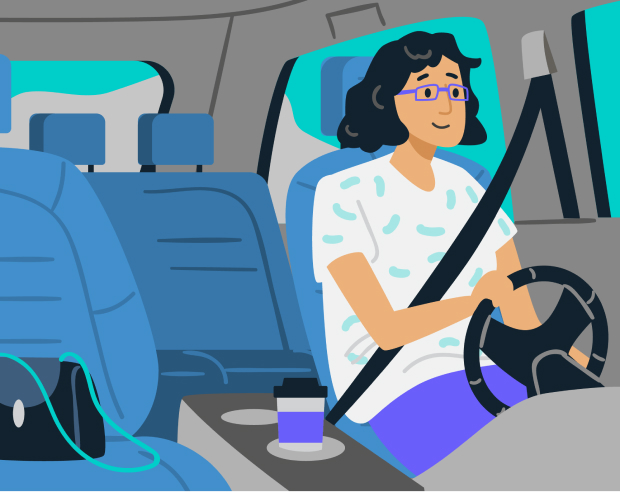Last Updated on 02.10.2024 by hrushetskyy
Driving Posture Tips and Stretches for a Long Trip
If you’re on a long drive, improving your driving posture and incorporating stretching into your routine is essential to avoid aches and pains. Small adjustments, like modifying your seat position, can make a big difference in comfort.
Whether you’re commuting to work, traveling cross-country on a vacation, or driving for a living, you’ve likely felt it at some point. Your lower back starts to ache. Your arms and shoulders start to tense from gripping the steering wheel. Your upper legs start to hurt from sitting too long.
If you’re in a vehicle for long drives, it’s important to improve your driving posture and incorporate stretching into your routine to prevent aches and pains.
Additionally, taking periodic breaks to get up and stretch is important. These habits will help you endure long hours behind the wheel or as a passenger and protect you from the lingering soreness that often follows extended trips.
Seat Position for Back Support
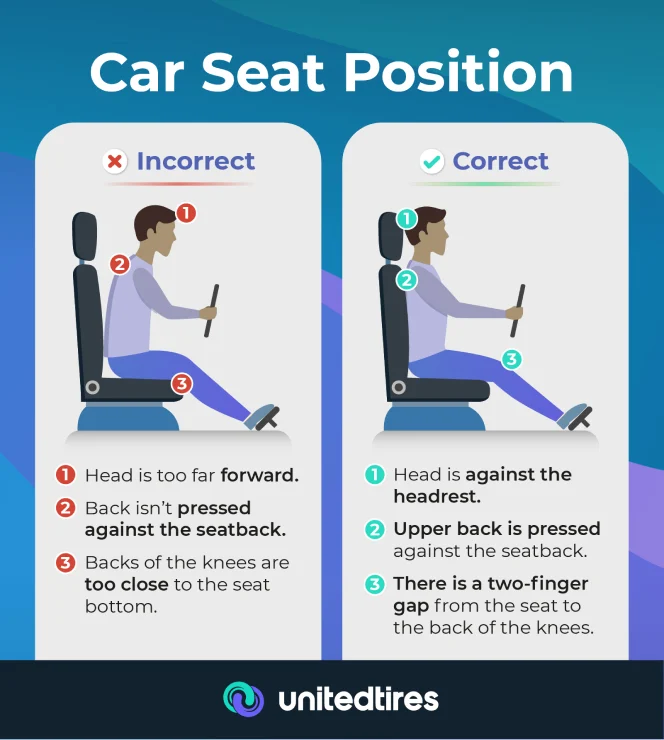
Ergonomics and proper posture are just as important when you’re driving as when you’re sitting at a workstation — perhaps even more so. Good driving posture can help minimize pain and fatigue.
Seat positioning is important. Make sure your seat is adjusted to achieve the best posture and maximum comfort. You should have enough legroom to operate the pedals easily while keeping your right leg slightly bent.
Your car seat should not recline too far. Adjust the seatback so it supports all parts of your back, creating an angle for your body of about 100 to 110 degrees.
Angle the front of your seat so it doesn’t press against the back of your knees, leaving a gap of two fingers between the seat and the back of your knees. Pull the steering wheel down and toward you to keep yourself from reaching too far, which can create fatigue in the arms and shoulders. Keep the head restraint approximately even with the top of your head and within 4 inches of the back of your head. This feature provides support that can help reduce whiplash in the event of a collision from the rear.
Seat Height and Inclination for Visibility
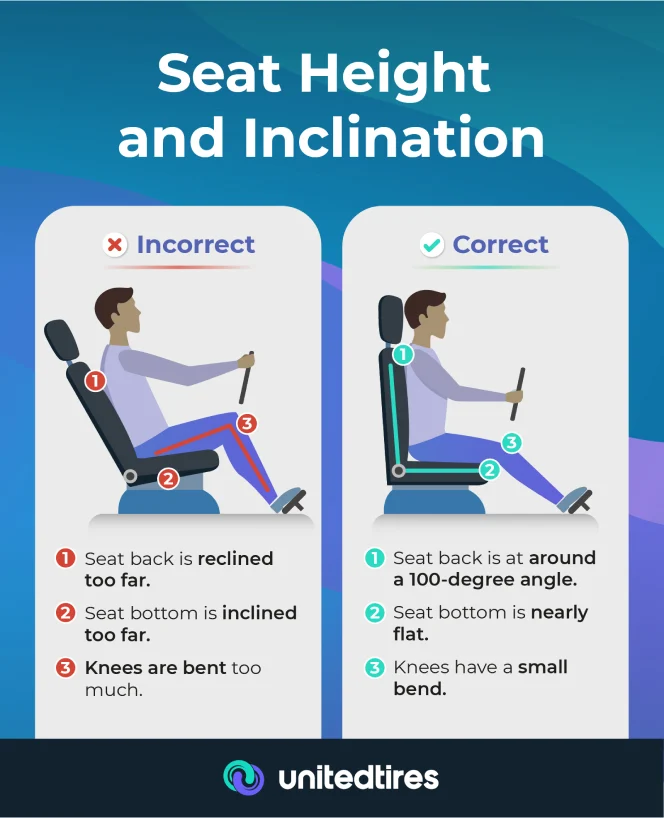
Your seat height should be adjusted so your legs and back are properly supported and you don’t have to reach too far. Good visibility is important so you don’t find yourself leaning forward or bending down to see both the road and your dashboard. Your hips should be at least as high as your knees to avoid putting too much pressure on the back of your legs.
If your car doesn’t provide lumbar support for your lower back (some seatbacks have an inflatable element you can adjust), consider getting a cushion or even using a rolled-up towel or pillow.
When it comes to visibility, make sure your rear-view mirror is adjusted so you don’t have to bend or twist to use it.
Steering Wheel Adjustment for Neck and Shoulder Comfort
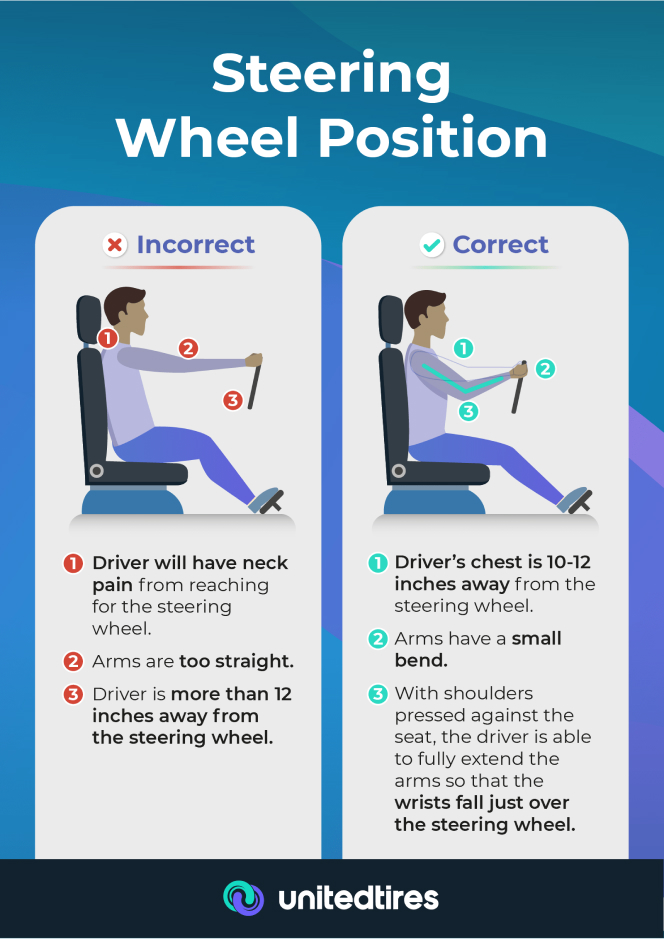
Make sure your steering wheel isn’t so high you have to reach up significantly, which can create arm and neck fatigue. The wheel should be close enough that you can bend your arms at about a 120-degree angle while driving. If you’re not close enough, move your seat forward.
You may recall being told to drive with your hands at the 10 and 2 o’clock positions on the wheel, but the 9 and 3 o’clock positions are safer in the event your airbag deploys. You’ll have to use your neck and shoulder muscles more in this position, but you can minimize the strain by gripping the wheel lightly with your fingers rather than your palms. In addition, this lower position may allow you to rest your elbow on the vehicle armrest to reduce stress and pain in your upper back.
Headrest Alignment for Neck Support
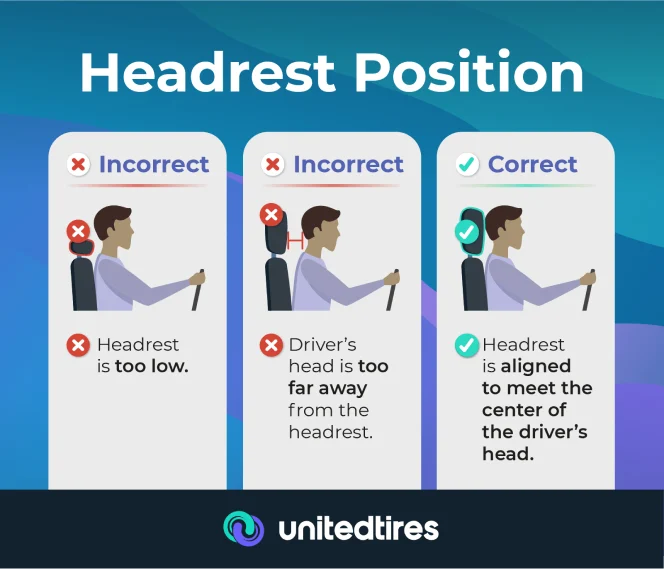
Your headrest should be close enough to your head to prevent whiplash in the event of a collision — no more than 4 inches away and, preferably, just touching the back of your head. However, it should not be pushed up against your head so tightly that it causes you to lean forward. This can create neck strain and reduce visibility. The top of the headrest should be no higher than the top of your head.
Seat Belt Safety
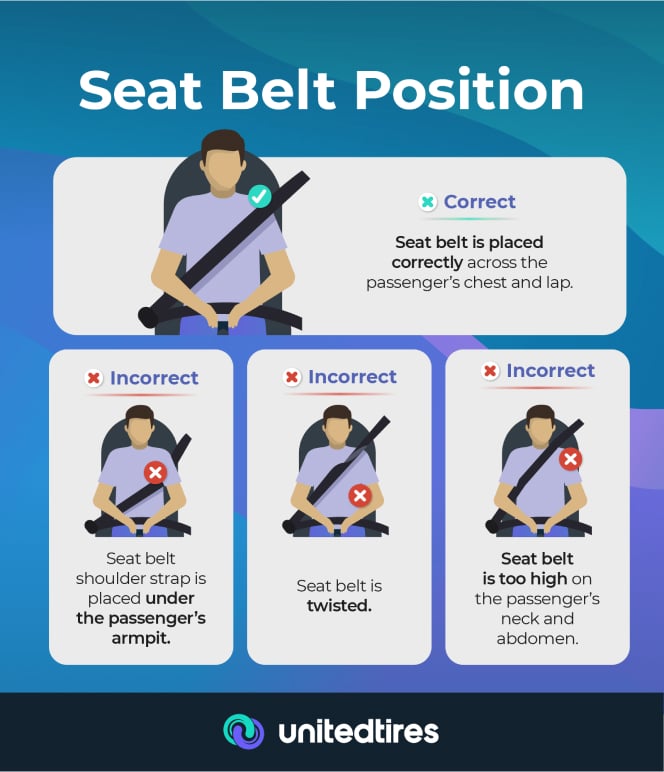
The National Highway Traffic Safety Administration (NHTSA) cautions that seat belts should be worn to minimize the risk of injuries in an accident. In many states, it’s the law.
A total of 35 states, plus the District of Columbia, allow officers to ticket drivers if seat belts aren’t worn by front-seat occupants, regardless of whether any other infractions have taken place. Fifteen states allow officers to write tickets for failure to wear seat belts if they see another infraction, and 39 allow some kind of enforcement for failing to wear rear seat belts.
It’s important not just to wear seat belts, but to wear them properly. Don’t wear a shoulder harness under your arm, for example, and be sure your lap belt is snug across your hips. Airbags are not a replacement for seat belts; they won’t protect you if you’re hit from the side or if you’re in a rollover accident.

Stretches for Drivers
It’s a good idea to stop periodically and stand up to stretch, but there are also stretches you can do while driving or riding in a car. You should always be sure, however, that you keep your eyes and attention on the road and are not distracted.
Neck Stretch
While looking forward, tilt your head to one side, put your ear to your shoulder, then hold that position for five seconds. Repeat this stretch on the opposite side, and go through this procedure two to five times.
When you’re stopped, you can turn your neck to one side, then the other, and hold for five seconds each time. You can also stretch your head forward, touching your chin to your chest. (For more stretches you can do when your vehicle isn’t moving, see below.)
Shoulder Stretch
Shrug your shoulders, lifting them as high as you can, then hold them there for a few seconds, release, and repeat. You can also roll your shoulders slowly, while still facing forward, to ease tension.
Back Stretch
Roll your rear end forward slowly, away from your seat, to create an arch in the small of your back. Hold that position for up to five seconds, then roll your back so it’s flat against the seat.
Stretches for Passengers
You don’t have to be in the driver’s seat to benefit from stretching to ease stress during car trips. Passengers can find themselves uncomfortable if they’re sitting for long periods, too. Here are some stretches passengers can do to ease tension and discomfort.
Oblique Stretch
Put your hands above your head, taking hold of your right wrist with your left hand, then exhale as you lean to your left from your ribcage. Hold that position for a few seconds, then reverse and repeat on the other side.
Arm Stretch
Leaning forward, put both hands behind your back and pull your shoulders back. Hold this position for five seconds and repeat. Drivers can do this exercise standing up when they’re pulled over.
Glute Stretch
Sit up straight and rotate your trunk to one side. Hold that position for five seconds and release, then turn to the other side.
Stretches To Do When Parked
Some stretches aren’t possible and others aren’t safe when your vehicle is in motion. If you’re parked, however, here are some that you can try that will still be helpful.
Cat/Cow Stretch
What do these animals have to do with stretching? It’s all about yoga. You start out as a cow, then pose like a cat. It works like this: Placing your hands palms-down on your seat, push your chest out and roll your shoulders back to create an arched-back cow pose. Then round your shoulders down again, assuming a cat pose.
Hand Stretch
Stretching your arms out past the steering wheel, bend your wrists down so your fingers are pointed down, and then bend them upward. Repeat 5 to 10 times.
Ankle Stretch
Rotate each ankle in a counterclockwise direction. Complete 5 to 10 full rotations. Repeat in a clockwise direction for each ankle.
Hip Stretch
Hip Stretch
Leg Stretch
You’ll have to get out of the car for this exercise because you’ll need to be standing up. Place your hand on a wall beside you to balance, then grab your outside ankle with your hand and lift your leg up toward your buttocks while keeping your knees together. Inhale and release one relaxed breath, then repeat on the other side. This will help stimulate blood flow to the legs after driving.
The Bottom Line
Many of the same tips that you’ve learned for avoiding poor posture at your desk can be applied, with modifications, in your car. You need to make sure your seat cushion is the right height, and that you’re at eye level with your windshield for a clear view. Your shoulder blades should be relaxed, and you shouldn’t be slouching or bending forward, away from the back of the seat.
Before you take a long drive, make sure to check your tire pressure and tire tread, and perform other routine maintenance tasks. And don’t forget to stop, take breaks, and stretch. This will keep you more comfortable on the road and make the trip a more pleasant experience.

